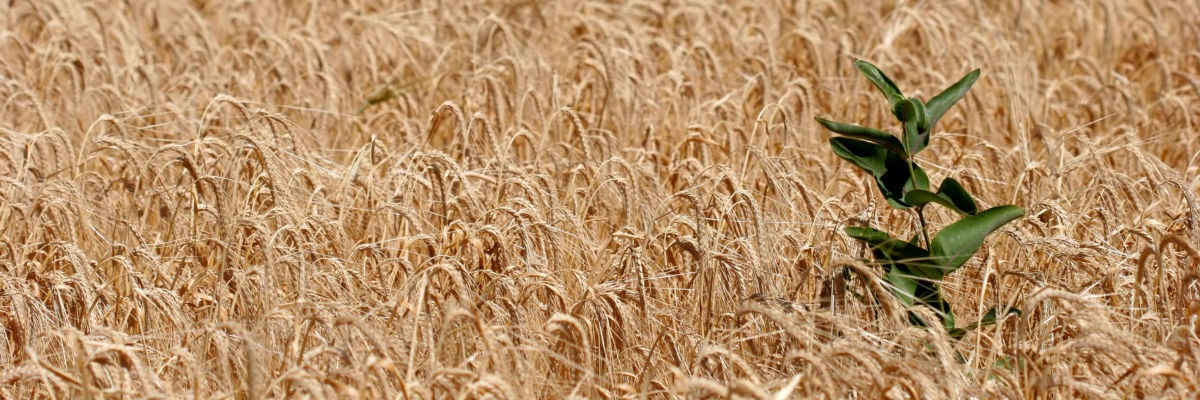
We see both justice and compassion in the parable of the wheat and the tares (or “weeds” in most translations)—justice in that the wheat is in the last day separated from the weeds, compassion in that they are allowed to grow together for a time.
I’m not a farmer, so I’ll hesitate to draw too much from the metaphor, but even my limited experience with flowers and vegetables has shown me how often it is difficult to tell for sure what is a weed and what is not. In our yard in Southern California, I remember many times where I had to call over my wife and ask, “Did you plant that? Did I? Is this something that we want?” It’s a tough call because, especially if you started something from seed, you may not know or remember exactly what it looks like. When it comes to grain, it turns out that there are a lot of weeds that look very similar to wheat—or to oats or barley or rice, whatever it is that you’re trying to grow.
We could apply this imagery to the moral life. Weeds are like vices that should be mercilessly pulled out. When the Fathers look at the controversial conquest of Palestine in the book of Joshua, they prefer the moral meaning: it’s no good letting just a little bit of lust, a little bit of murderous intent, remain; better to kill the whole city and raze it to the ground.
I say this by way of contrast, though, because that is not the primary meaning offered by our Lord in his parable. Here we’re talking not about the internal spiritual life, but the visible life of the Church in the world. The Church will always be, in this life, what St. Augustine often calls a corpus permixtum, a mixed body. This reading of the parable was important for Augustine because he faced a particularly strong version, in the Donatist heresy, of a temptation that appears in almost every age toward a Church made up exclusively of the pure. Catholics need to follow Augustine’s teaching carefully here, for we could easily get caught up in the traditional language of the Church’s perfection—it’s right there in the creed with one, holy, catholic, apostolic—and forget the simultaneous teaching that, on the other hand, in this age, the Church is never without sin in her members. Because the Church is a body of people, not just an abstraction, she will always be made up of those who vary in their degree of communion with the Church in her perfect essence.
Indeed, in our age of Christian division, we might point out the obvious visible fact that there are many Christians who are, sacramentally, baptized into Christ and his Church yet without sharing in the full visible communion, or the fullness of sacramental life, which the Catholic Church has received from the Lord and his apostles. Such Christians are, in a very real way, members of the Church, even while in some other very real ways, they are not. There are visible realities and invisible realities of communion, and the two do not always match up.
Some Catholics worry that the ecumenical thinking of Vatican II in the decree Unitatis Redintegratio, or even in Lumen Gentium, watered down the Catholic understanding of the Church. Without going into a full reading of those texts, I do not think that is the case. For example, Joseph Ratzinger believed that the teaching that the Church of Jesus Christ “subsists in” rather than simply “is” the Catholic Church actually fortifies the traditional Catholic understanding of the Church. It doesn’t mean that the Church isn’t the Church and has disappeared into some vague abstraction. It means rather that the Church is the Church in a way that defies simplistic explanation. She is at the same time a mixed body of sinners and the immaculate bride of the Lamb. And this paradoxical life is hard, because it requires constant discernment and vigilance on the part of her members, whatever their station.
I know it’s commonplace to joke about whether the pope is Catholic, but all the saints know that it’s no joke. Even the pope has to ask himself, and should ask himself: am I actually living in full communion with the Church of which I am the temporal ruler? Am I the wheat, or am I a weed?
When you put it that way, the Lord’s insistence that he will not sort everything out in the present age seems a little more comforting. It is annoying, maybe, if you think the weeds could be only those people over there—those people who send their kids to public school, or the annoyingly large homeschool family, or the childless couple, or the people who always leave Mass early, or the ones who come to church and then immediately go out picketing for immoral causes. Sure, some of those people might be weeds, but so might I. Only time will tell.
Our selection from Wisdom likewise speaks of the mysterious combination of patience, justice, and clemency in God. A theologian will tell you that God is “simple” in a philosophical sense, so his justice and his mercy are not actually distinct, but simply identical with his nature; it is only in our impartial vision that we see them as distinct or competitive. The author of Wisdom says all this in his discussion of salvation history, and especially the Exodus—a moment when, remember, the people of Israel have to wait 400 years for redemption. That’s a helpful timeline to keep in mind for those of us who worry that the world is going to fall apart because the pope appointed a bad cardinal. The Exodus story is also full of moments when God’s patience with evil is almost maddening.
But, again, it’s maybe a little less maddening if you dare to ask whether you yourself are the object of God’s patience. What if God is waiting for me? I can’t speak to God’s specific providence for each person, but I think it’s fair to say the answer is pretty much yes. What Scripture tells us about God is that his mercy endures forever, his compassion knows no bounds, his eye is on the sparrow, he desires every sinner to come to repentance.
We’ve just come out of the month of the Sacred Heart and entered the month of the Precious Blood, but the message of mercy is the same. If I can quote again from my favorite Preface in the Roman Rite, we pray to the Father that the Heart of Jesus, “manifest as the shrine of thy heavenly bounty, might pour forth for us floods of grace and compassion; and that, since it hath never ceased to burn for us with ardent longing, it might be the resting place of them that love thee, and the ever-open refuge of safety for the penitent.” It is only there, in that refuge of safety, that we can become wheat. And that heart is infinitely large.



